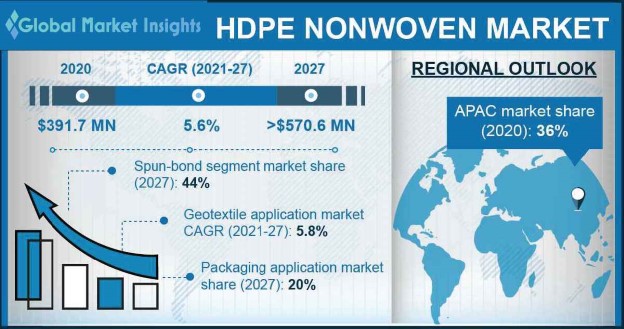Home > Chemicals & Materials > Textiles > Nonwoven Materials > HDPE Nonwoven Market
HDPE Nonwoven Market Size
- Report ID: GMI5013
- Published Date: Mar 2021
- Report Format: PDF
HDPE Nonwoven Market Size
HDPE Nonwoven Market size was valued at around USD 391.7 million in 2020 and will exhibit a growth rate of over 5.6% CAGR from 2021 to 2027. Increasing demand for geotextiles in various applications, such as road construction, drainage, and agriculture, is projected to boost the demand for HDPE nonwoven in geotextile production.
HDPE (High Density Polyethylene) is a petroleum-based thermoplastic polymer. These thermoplastic polymers possess excellent strength to weight ratios. HDPE nonwovens are widely used in various applications including industrial packaging, medical packaging, geotextiles, protective apparel, building envelopes, etc., owing to their versatile properties such as lightweight, durability, tear resistance, and recyclable.
The rising application of HDPE nonwovens in geotextile is one of the major factors driving the overall industry growth. Additionally, the surging usage of the product in medical packaging is likely to offer new growth opportunities to the global HDPE nonwoven market over the coming years.
| Report Attribute | Details |
|---|---|
| Base Year: | 2020 |
| HDPE Nonwoven Market Size in 2020: | USD 391.7 Million |
| Forecast Period: | 2021 to 2027 |
| Forecast Period 2021 to 2027 CAGR: | 5.6% |
| 2027 Value Projection: | USD 570.6 Million |
| Historical Data for: | 2017 to 2020 |
| No. of Pages: | 162 |
| Tables, Charts & Figures: | 143 |
| Segments covered: | Type, Application |
| Growth Drivers: |
|
| Pitfalls & Challenges: |
|
The rising penetration of HDPE nonwoven in the packaging sector especially in regions, such as North America and Asia Pacific, is projected to drive the overall industry. The surging medical device industry mainly in the U.S., Japan, and India has further propelled the demand for packaging, thereby expanding the HDPE nonwoven market growth. Furthermore, the rising application of HDPE nonwoven in industrial protective apparels is likely to boost the market over the next few years.
HDPE nonwoven apparels are comfortable and long-lasting, providing protection against a wide variety of chemical threats and hazards. Additionally, they also protect from small harmful particles such as asbestos, lead, and mold.

